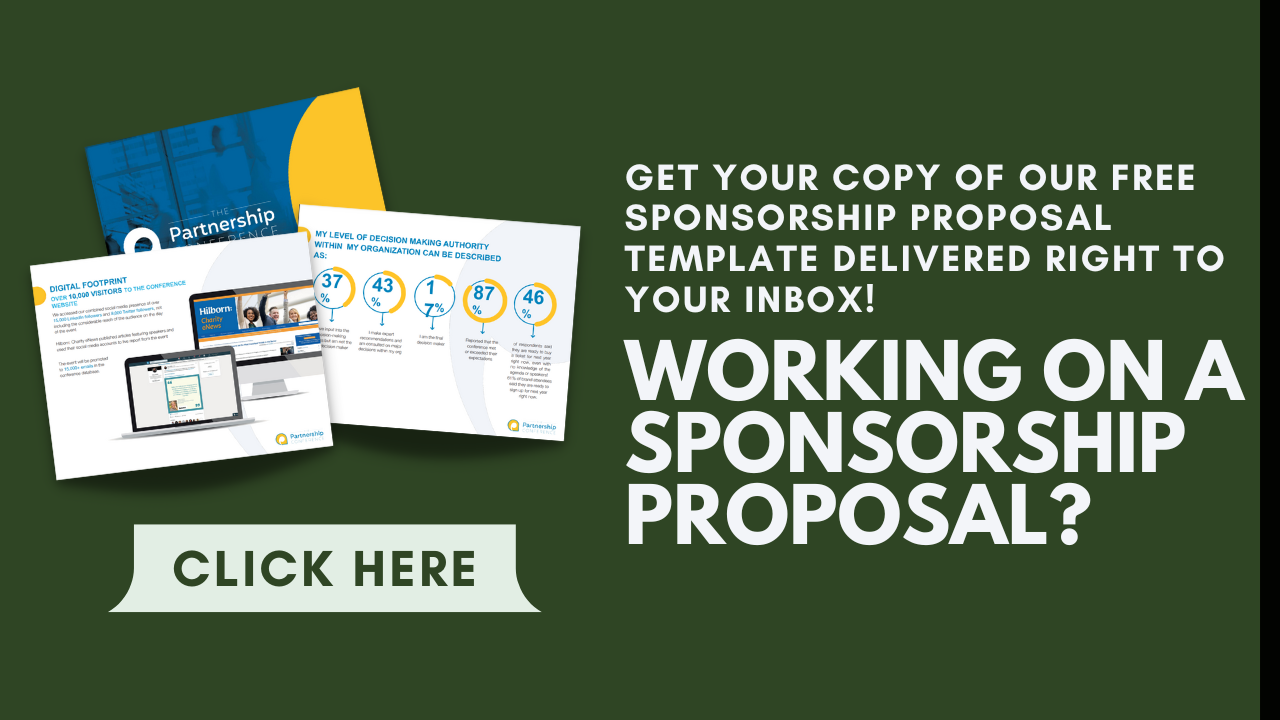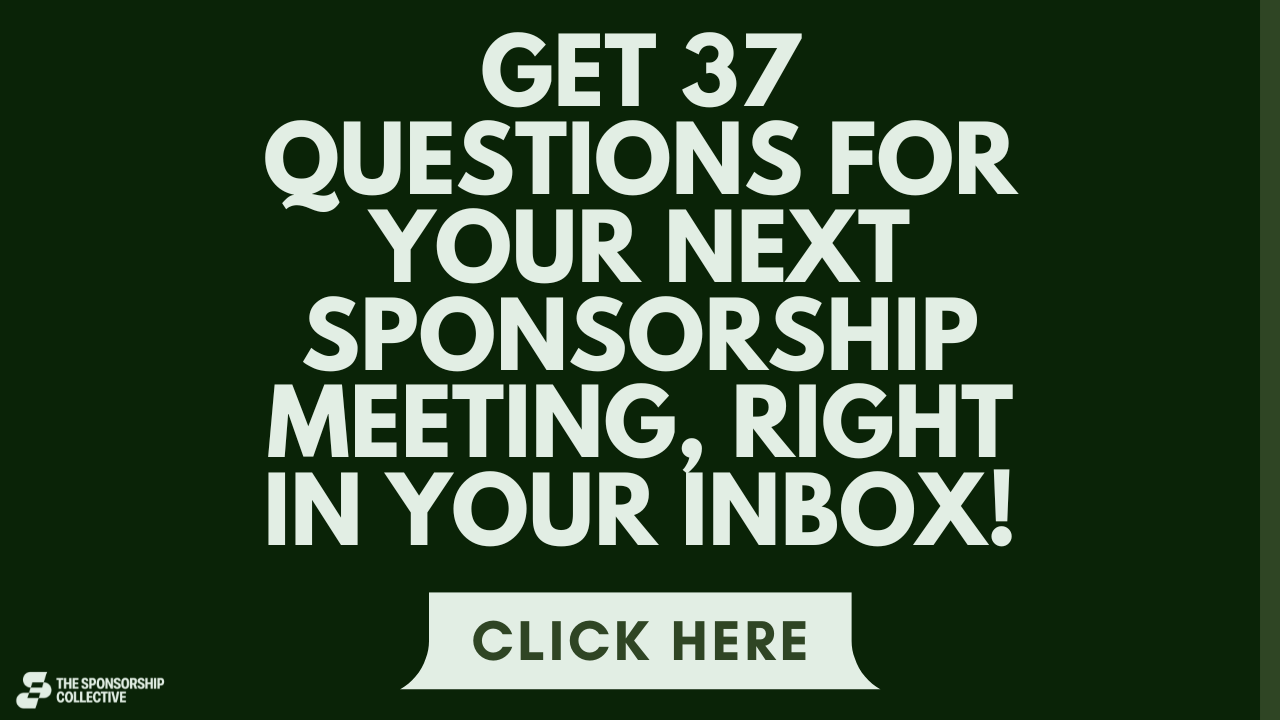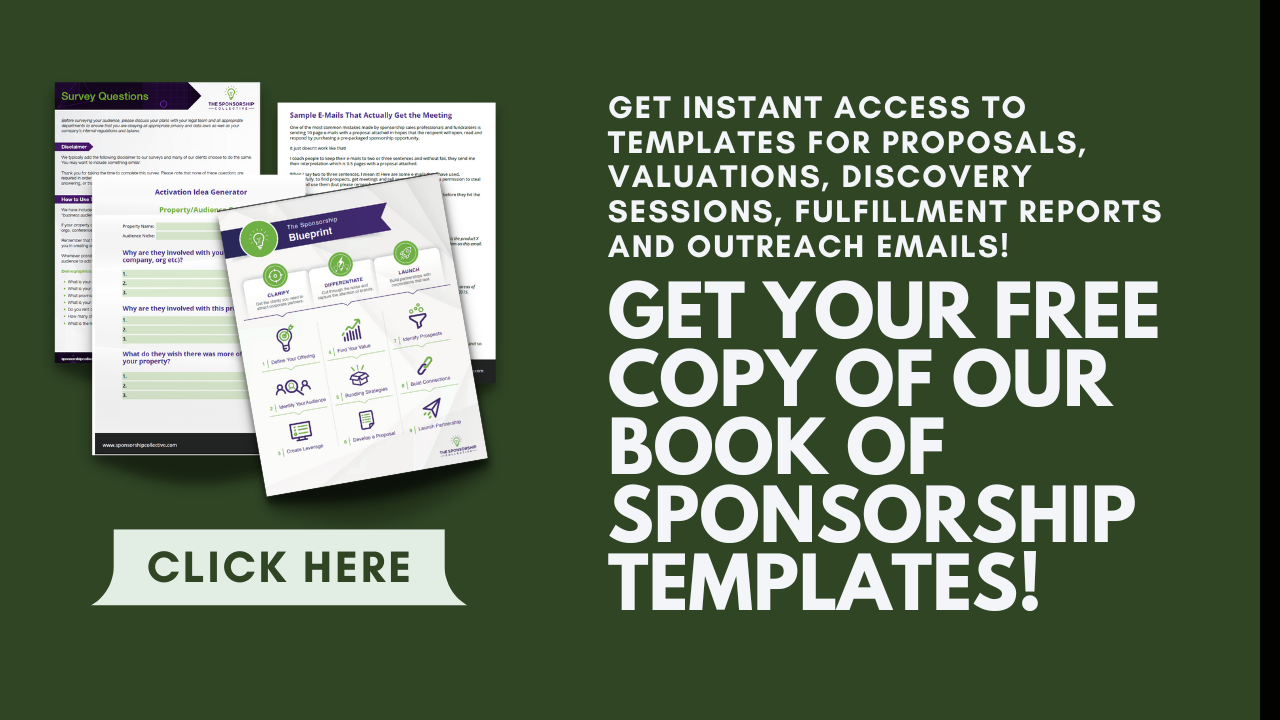Our sector has an outright obsession with the sponsorship package! Of course, sponsorship packages have their place and play a role in sponsorship sales, and I’ve written about the subject extensively here.
If you find yourself focused on building the perfect sponsorship deck before you start talking to sponsors, you’re in big trouble.
Here are 27 things you can do right now to move the needle on your sponsorship program, none of which require you to wait for final approval on your sponsorship deck!
- Create 5 “out of the box” activation ideas that you know your audience will love and offer them to your current sponsors!
- Update your valuation calculator to include an ROI calculator
- Stop thinking “philanthropy” and start thinking about the power of your audience
- Schedule your first Business Breakfast
- Start doing the Friday Five this week
- Create a fulfillment report template for your organization
- Schedule a follow up meeting after your next event and ask your sponsors for feedback
- Run an inventory building workshop for your team
- Make friends before you need them! Go for coffee with your prospects and ask them for nothing at all
- Conduct a valuation of your assets
- Make a list of the objections you hear most often from your prospects and find a solution (not a better pitch…an actual solution!)
- Survey you audience and stop guessing at who they are
- Book five discovery sessions with your prospects
- Invite your boss to a discovery session
- Hold a sponsor summit
- Do some prospect research and then research some more
- Run an education session for your board of directors
- Identify 50 sponsorship assets that do NOT require logo placement
- Write and send 10 emails to 10 prospects using no more than 3 sentences
- Go to a meeting with nothing in your hands and when you leave, don’t leave them with anything
- Define and research your competitors
- Schedule your cold calls first thing in the morning
- Set up a sales tracker using no more than 7 stages
- Define your social media followers
- Create an activation template for your team
- Educate yourself on current sponsorship trends
- Join our LinkedIn group and connect with other people just like you
Create Five “Out of the Box” Activation Ideas You Know Your Audience Will Love and Pitch Them to Your Sponsor
Bear in mind that “out of the box” doesn’t mean your activation lacks functionality. You can never distract from a low-quality activation with flashiness. Rather, when I say “out of the box,” I’m referring to uniqueness.
Does coming up with activation ideas have to be difficult, even if you’ve never done it before? Not at all! I have so many resources you can use. This one, which contains seven ideas I would say meet the criteria for “out of the box,” will help you get started.
I also rounded up all of 2023’s most noteworthy activations, or you can learn the secrets behind why activations are successful.
Update Your Valuation to Include an ROI Calculator
An ROI calculator will make valuing simple. Far too often, I see sponsorship seekers make egregious errors with their valuations, such as copying others or fudging the numbers. Sponsors want to know how you calculated the value of your assets and activations, and using my ROI calculator will make that simple.
Stop Thinking “Philanthropy” and Start Thinking About the Power of Your Audience
I can’t talk about assets and valuations without mentioning audience. Your most powerful, valuable asset isn’t a speaking arrangement, naming rights, social media post bundles, or event space. It’s your audience!
Whatever your sponsor wants ties back to your audience. More leads? Audience. Higher conversions? Audience. More website traffic? Audience. Greater sales? That’s right, audience.
You must understand your audience as well as possible. I require those who join the Sponsorship Accelerator, my program here at the Sponsorship Collective, to create 25 data points on each audience group.
Is that excessive? Not at all! Sponsors appreciate curated, ultra-segmented data to tell them how valuable your audience is.
Schedule Your First Business Breakfast
I discussed the basics of the business breakfast here, so take a look at that post if you missed it. Essentially, the business breakfast is an informal opportunity to talk shop with potential prospects. Plus, there’s food! It’s not free, but at least you can leave with a full belly.
Start internally when determining who you will invite to your business breakfast, tapping into your existing contacts and colleagues, then building your list out from there.
Start Doing the Friday Five This Week
In the above link on the business breakfast, I also recommend a strategy called the Friday Five, which is key to generating more than 390 warm prospects in your sponsorship pipeline.
So, what is the Friday Five? Every Friday, save for two weeks of the year, you connect five sponsorship prospects to your referral network. Try doing it at around 1 p.m. Ask your network if they can refer you to anyone, then write an email to that person so your contact can send it on your behalf.
LinkedIn is an excellent tool for helping you research your prospects to ensure you have contacts in common.
Create a Fulfillment Report Template for Your Organization
I have an easy-to-use sponsorship fulfillment report template you should use, but don’t feel like you have to copy it. You’re free to modify the pages to suit your brand and sponsorship goals.
Do whatever makes it easiest to deliver the fulfillment report, ideally within 24 to 72 hours of your event. The report opens the door to a frank dialogue about what your strong and weak points were during the sponsorship arrangement and possibly presents the opportunity for longer-term sponsorship renewal.
Schedule a Follow-Up Meeting After Your Next Event and Ask Your Sponsors for Feedback
Is your fulfillment report ready to go? Great! Once you finish it, it’s time to get in touch with your sponsor and book some time to talk with them about its contents. The sooner you do this after your event, the better, because it’s still fresh in everyone’s mind, including the fine details.
I know that no one likes accepting constructive criticism but think of it more as feedback. Talking about the good, bad, and the ugly of your sponsorship opportunity will help you improve for next time, whether you work with that sponsor again or someone different.
Run an Inventory-Building Workshop for Your Team
Getting your team on board with sponsorship requires providing knowledge, hence why I suggest an inventory-building workshop. Train your team on what goes into organizing assets and activations. Try building a sponsorship inventory with some sample assets, then value it to see how successful your sponsorship property is!
Make Friends Before You Need Them!
Having friends in high places is always advisable. If you have the time, go for coffee with your sponsorship prospects. However, don’t ask them for anything at all, just their company. Get to know them a little, as this will make it easier to understand their business needs and challenges later.
You don’t have to be besties, so don’t spend too much time befriending your sponsor. One coffee meeting is all you need per prospect.
Conduct a Valuation of Your Assets
You don’t need a sponsorship package for this next part of the process, valuations. By this point, you should have chosen your assets and activations. Valuing them will put a price tag on each so you can determine which to offer to your sponsor and which to discard.
Is sponsorship valuation difficult? Not if you know the key requirements. You must research the market value of each service you offer, then compare standard service quality against your own. Factors like originality and audience can drive your value up.
As I mentioned, be ready to show your math!
Make a List of Objections You Hear Most Often from Your Prospects and Find a Solution
The goal here is not to pitch “better.” Being more salesy in your pitches isn’t what’s holding you back from achieving your sponsorship goals. Failing to overcome the objections that sponsors give you is what’s holding you back.
Again, I get it. It’s not easy to hear criticism, but it’s the only way you’ll grow and improve. Be willing to make changes in how you do sponsorship so you can turn more of those no’s into yesses!
Survey Your Audience and Stop Guessing Who They Are
Audience data is the backbone of sponsorship, but how do you acquire it? Through an audience survey, of course!
Surveying your audience allows you to dig deep into their motivations, beliefs, thoughts, and opinions. You’ll also obtain geographic and demographic information, but what you really want are psychographics.
Why is that? Those are the only way to peel back the curtain and really get to know your audience. Further, the brands they mention using should go on your prospects list, as those are brands your audience already likes, engages with, and has loyalty toward.
Send a survey via email or an online form, and keep the number of questions short.
Here are a few more pointers. Give your audience ample time (maybe a month) to send in their responses, and entice them to fill out the survey by offering a giveaway, contest, or sale in conjunction with their participation.
Book Five Discovery Sessions with Your Prospects
Using audience survey responses to build your prospects list means you should be able to book five discovery sessions no problem. Keep in mind that these meetings don’t all have to be on the same day. Space them apart so you can put the time, attention, and focus into each prospect that they deserve.
Getting five in the books at once is a surefire sign you’re on the right track with your sponsorship goals.
Invite Your Boss to a Discovery Session
Getting everyone enthused and ready to work on sponsorship opportunities within your office doesn’t only mean appealing to your colleagues. Above all else, you need your boss on board, and one of the best ways to do that is to let them participate in a discovery session.
Better yet, let them get involved. Share your prospect information and ask your boss to come up with a few questions. Then, at the meeting, let them ask some questions. If they do more than sit passively, they’ll become invested in the sponsorship opportunity because now they have some skin in the game.
Hold a Sponsorship Summit
A what now? A sponsorship summit!
This probably isn’t what you picture in your mind when you hear the term “summit,” and I get you. I only advise that the summit matches your brand and is an annual event. That’s right, every year, without exception.
A small summit is best for your first one. You can honestly do a business breakfast in several places where your sponsors are, hosting between five and 30 people, and that would do fine.
The point of a sponsorship summit is to spread your knowledge, brainstorm together, and accrue feedback about sponsorship ideas and offerings.
That’s about it. It’s not a sales meeting, so there is no pitching or closing a deal. It’s largely informational but isn’t quite a discovery session. It’s more like an opportunity to pick the minds of several experts while sharing your own contributions and insights.
Do Some Prospect Research and Then Research Some More
While the higher caliber of prospects you’ll obtain using audience data are generally a better match for your attendees or customers than other brands, that doesn’t mean they all automatically go onto your prospects list.
As I always tell sponsorship seekers, doing your due diligence is required. That means researching prospects thoroughly, examining their values, brand mission, and products and services to determine if they’d be a match to work with you.
If not, you should have ample enough other prospects that you can afford to be somewhat choosy.
Run an Education Session for Your Board of Directors
Getting your board of directors engaged is no easy task, as they may not be well-versed in sponsorship to begin with. Fortunately, with a bit of know-how and patience, you can help them learn about the merits of sponsorship.
An education session can help get everyone on the same page. Have other team members attend who you’ve taught sponsorship to so they can assist, answering questions and explaining techniques.
Identify 50 Sponsorship Assets That Do NOT Require Logo Placement
That’s right, I’m challenging you to find 50 sponsorship assets that aren’t logos. That can be practically impossible for the beginner sponsorship seeker, but by all means, I insist.
And why do I insist? It’s one of the biggest sponsorship realities that logos are low-value. I know, that comes as a shock to many sponsorship seekers, but it’s true!
Think about it for a moment. What does a logo achieve? Only brand awareness really, and sometimes, it even fails at that objective. For example, if you have several sponsors and the best asset you offer is logos, there will be so many brand logos at the event competing for an attendee’s attention that they might not remember any one specific brand.
Moving away from logos is one of the best ways to ensure your sponsorship program drives more money. Almost any asset and activation you can offer besides logos is going to be higher-value, from speaking arrangements to naming rights, interviews, product placement, photo walls, refreshment stations, exclusive VIP events, you name it.
You don’t have to come up with all 50 asset ideas at once. Start with five, then see how your list grows to 10, then 20, and before you know it, you’ll already be halfway done. Involve others in the brainstorming process to keep the creative juices flowing.
Write and Send 10 Emails to 10 Prospects Using No More Than Three Sentences
It’s common sponsorship knowledge that one of the top reasons prospects ignore your emails is because you overload them. A good cold email to a potential sponsor only needs three sentences, max.
Yes, I’m serious. All you have to do is introduce yourself (briefly, might I add), mention why you’re emailing (to set up a meeting), and then propose a date and time to meet. This way, the prospect can either agree to that time or propose their own.
You should have identified at least 10 prospects by this point, so write a tailored email to each, then send them one by one. That’s right, no mass-emailing here! That might save you time and effort but it never yields the results you want.
Go to a Meeting with Nothing in Your Hands and When You Leave, Don’t Leave Them with Anything
Again, this is a valid sponsorship strategy that proves you don’t need a sponsorship package or proposal to propel a deal forward.
When you have a discovery session, you should never have a pitch deck and mountains of material on your person. You’re trying too hard to make the sale, and that’s not what the discovery session is about.
That’s not even what subsequent meetings are about. Trust me, if a sponsor wants to see further documentation from you, they will ask for it. Until then, don’t bring any paperwork.
This is going to feel really foreign and weird to you at first, but you will adjust, and once you do, you’ll realize going forward that handling sponsorship meetings any other way won’t yield the results you want.
Define and Research Your Competitors
The road to sponsorship requires stopping off and learning about the competition. It helps to know what they’re doing for myriad reasons. You can see what kinds of sponsors they’re targeting and if you’re within the same financial ballpark as them.
You can also learn more about the activations and assets they offer. You shouldn’t immediately copy what they’re doing, just keep it in mind when ideation time comes.
That said, sponsorship success tends to look a little different for everybody, so bear in mind that what works for you might not for another company and vice-versa.
Schedule Your Cold Calls First Thing in the Morning
Who likes cold calling? Certainly not I, although I recognize it as a job requirement.
You probably don’t like it either, right? So, let me guess what happens. You look at your planner for the day and say you’ll take care of the cold calling in the afternoon. Then the afternoon comes and you’re too tired to pick up the phone, so you push it off to tomorrow.
Then, you proceed to do the same thing tomorrow, and the day after that. Before you know it, one week, then several have passed, and you still haven’t contacted a prospect by phone.
I can tell you that cold calling does get easier, but not until you begin doing it. To avoid pushing it off endlessly, schedule your cold calls in the morning. People are usually more energized and less busy in the morning, so you might get a better response rate.
Set Up a Sales Tracker Using No More Than Seven Stages
I love a good sales tracker as much as the next sponsorship seeker. However, if yours has more than seven stages, you’re making it unnecessarily complicated. Not only will it be difficult to quantify data and effectively determine your sales rate, but you’re also chewing into valuable time whenever you use your sales tracker.
Try cutting down and see what happens. You can thank me later!
Define Your Social Media Followers
You’re already aware of how I recommend learning more details about your audience, right? Well, the same should go for your social media followers. After all, they’re an extension of your audience.
Review the followers you’ve acquired on each social media platform your brand has a major presence on. Next, do some digging into profiles, gleaning as many psychographics, demographics, and geographics as you can.
This isn’t a fast process (but then again, neither is surveying your audience and extrapolating data from the results), but you will begin to gather audience insights that will be very valuable for you.
You can compare your social media audiences against your target audience to determine what kinds of people you want engaging with your social content. You can then post content tailored to those groups to get your posts in front of them.
Create an Activation Template for Your Team
As you get familiar with sponsorship activation, build an activation template the whole team can use. Having a handy template will streamline processes and help you kickstart your activation ideation for your next sponsorship opportunity.
The template can be as simple or detailed as you need it, but make sure it’s easy to follow for the benefit of the team.
Educate Yourself on Current Sponsorship Trends
The basic foundations of sponsorship largely remain the same, but trends come and go in this industry all the time, sometimes rather quickly. I’ve written about sponsorship trends quite a lot on the blog. For instance, here’s a rundown of the biggest trends shaping the industry in 2024.
What’s old can become new again, and what’s new can be out of style in a year or two. That’s why I tell you that it’s worth staying abreast of trends but not necessarily adjusting your sponsorship process to each and every one.
You must get good at identifying trends with staying power. That will come with practice.
Join Our LinkedIn Group and Connect with Other People Just Like You
Yes, okay, maybe it’s a bit of a shameless plug, but you can get some great sponsorship information out of the Sponsorship Collective’s LinkedIn group, which is free to join. While you’re here, may I recommend you become a member of our private Facebook Group, where you can gain exclusive access to sponsorship tips and strategies?
You also shouldn’t miss the Sponsorship Collective’s YouTube channel, where I break down a lot of complex sponsorship topics into easily digestible videos.
FAQs
When Should I Put Together My Sponsorship Package?
The package should come after your discovery session and after a sponsor requests more documentation about your working arrangement. You also must value first. Putting together a sponsorship package before then is a waste of everyone’s time, as a sponsor will quickly realize you didn’t customize your offerings.
What’s the Problem with Gold, Silver, and Bronze Sponsorship Tiers?
It’s an outdated way of presenting assets. Sponsors also don’t like it because they don’t get the flexibility to pick and choose which services they want. I always tell my clients to customize their assets, but a hybrid model with some customization also works for some sponsorship properties.
Wrapping Up
I know it was an exhaustive list, but that only goes to show that you don’t need a sponsorship package to bring in more sponsorship dollars. The tips I shared are largely foundational, and that wasn’t an accident.
Building your sponsorship property brick by brick gives you a good base to work with and continue building upon. Follow these steps and watch your sponsorship opportunities blossom!
- About the Author
- Latest Posts
Chris Baylis is the Founder and Editor-in-Chief of The Sponsorship Collective.
After spending several years in the field as a sponsorship professional and consultant, Chris now spends his time working with clients to help them understand their audiences, build activations that sponsors want, apply market values to their assets and build strategies that drive sales.
Read More about Chris Baylis




